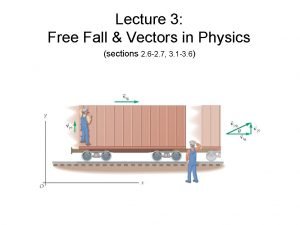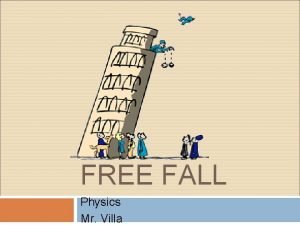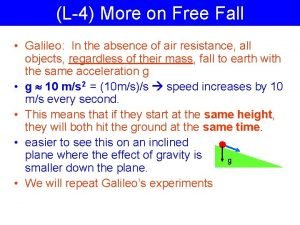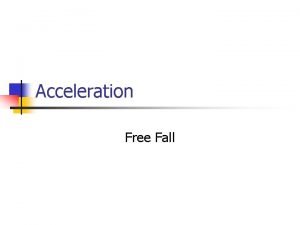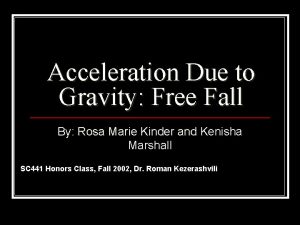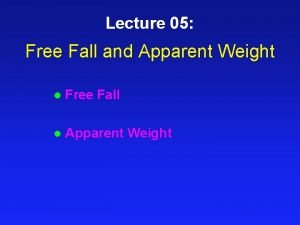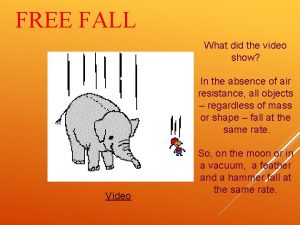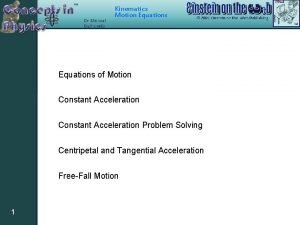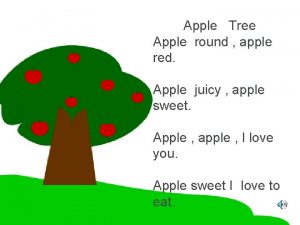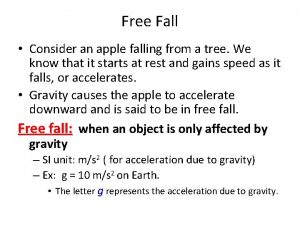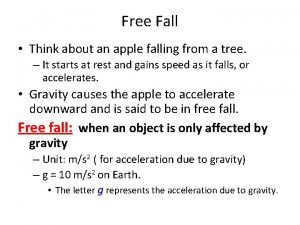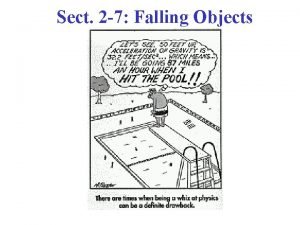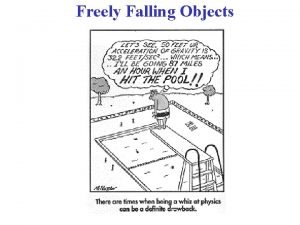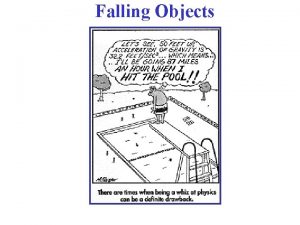Free Fall Free Fall Consider an apple falling












- Slides: 12

Free Fall

Free Fall • Consider an apple falling from a tree. We know that it starts at rest and gains speed as it falls, or accelerates. • Gravity causes the apple to accelerate downward and is said to be in free fall. Free fall: when an object is only affected by gravity – SI unit: m/s 2 ( for acceleration due to gravity) – Ex: g = -9. 8 m/s 2 on Earth. • The letter g represents the acceleration due to gravity.

– Equation: v = vi + at • v = velocity or speed (m/s) • a = acceleration due to gravity (-9. 8 m/s 2 on Earth) • t = elapsed time (s) **Hint - as soon as you see any of the following phrases in a word problem, write a = - 9. 8 m/s 2 for a given: free fall, falling, dropped, thrown** thrown

Remember, the object’s velocity increases by -9. 8 m/s every second it falls Time falling 0 s 1 s 2 s 3 s 4 s 5 s 6 s 7 s 8 s 9 s velocity

Check Your Understanding What would the speedometer reading on a falling rock be 4. 5 seconds after it drops from rest? üv = ? a = 9. 8 m/s 2 t = 4. 5 s v = at v = (-9. 8 m/s 2) (4. 5 s) v = 44. 1 m/s

How about 8 seconds? ü v=? a = 9. 8 m/s 2 t = 8. 5 s v = at v = (-9. 8 m/s 2) (8. 5 s) v = 83. 3 m/s How about 15 seconds? ü v=? a = 9. 8 m/s 2 t = 15 s v = at v = (-9. 8 m/s 2) (15 s) v = 147 m/s

• Now consider an object thrown straight up. It will continue to move straight up, then it comes back down. • At the highest point, the object changes its direction and the objects instantaneous speed is 0 m/s. • Whether the object is moving up or down, the acceleration of the object is always -9. 8 m/s 2.

• Because an object in free fall increases the rate of distance covered every second, we cannot use v =d/t to find distance. – Equation: d = ½ at 2 • d = distance (m) • g = acceleration due to gravity (9. 8 m/s 2 on Earth) • t = elapsed time (s)

Use the distance formula to find how far the object will fall at each second Time falling 0 s 1 s 2 s 3 s 4 s 5 s 6 s 7 s 8 s 9 s Distance travelled

Check Your Understanding What is the distance an object falls in one second? üd = ? a = 9. 8 m/s 2 t=1 s d = ½ at 2 d = ½ (9. 8)(12) d = 4. 9 m

The problem with air • When you drop a crumpled piece of paper and a flat sheet of paper they should fall and hit the ground at the same time, but do they? – The reason the crumpled piece of paper hits the ground first is because it experiences less air resistance • A frictional force (means it goes against motion) caused by air • The greater the surface area of an object, the more air resistance it feels

1. What does it mean if an object is in free fall? 2. How do we calculate speed of an object if it is in free fall? 3. What does g represent? What’s is it’s numerical value? 4. How do we calculate the distance an object falls when it is in free fall?


